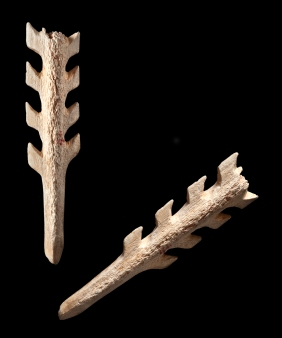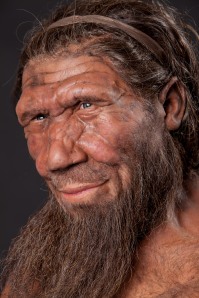I always feel like I’m trying to play catch up with what I should have learnt during my undergraduate archaeology classes, if only I’d been a little more enthusiastic back then. And then an exhibition like this comes along that encompasses so much of it and new discoveries as well, while explaining everything in an easy to understand way. I just hope some of it sticks in my memory this time.
The exhibition begins with the recent discovery of 850-950,000 year old ancient human footprints on the Norfolk coast at Happisburgh (pronounced Hayesbrough). To put that into context, Homo sapiens did not appear in Britain until c.40,000 years ago, so we’re talking about very old human ancestors walking on what would have once been land connected to mainland Europe (to get an idea of the changing status of ‘Britain’ as an island these images from Natural History Museum are really useful and you can see why there were different phases of habitation).
It then takes you through the different stages of human life in Britain, with stone tools, animal bones, human bones and other remains on display. It also talks you through some of the dating techniques that are used – which is something that is never straightforward as often numerous techniques are used to establish estimated dates, and this comes across well when talking about the site at Happisburgh. For instance, magnetism (relating to the last reversal of the Earth’s magnetism) and an analysis of the animal remains found helped date the layers that ancient tools had been found in.
The exhibition does a good job at putting things in context and some of the devices they’ve used I hope will help keep the timeframes and events in my head. For instance, 450,000 years ago Britain cooled down to such freezing temperatures that no human life could be sustained. This period is given importance by an ice blue corridor in the exhibition before moving on to the next important stage – the emergence of Neanderthals.
Another image they’ve used is of animals such as lions, elephants and rhinos against a modern backdrop of Trafalgar Square. This, again, is talking about a period (c.125,000 years ago) when it was too cold for human habitation; humans had moved further south, but by the time the temperatures rose again Britain had been cut off from Europe by the emerging ‘English Channel’ and so the animals that had remained led a human free life.
The exhibition ends with the return of the Neanderthals, the emergence of modern humans and suggestions for why Homo sapiens ended up being the only species left on the planet.
I spent a long time going round this, trying to get my head around everything, but it’s not overly detailed and doesn’t go into too much scientific depth, with each section put into context succinctly at the start meaning that you could get the basics quite easily without concentrating too hard.
Natural History Museum, Cromwell Road, London, SW7 5BD
Until 28 September 2014
£9 adults


